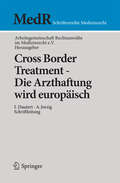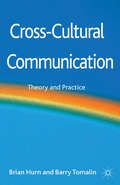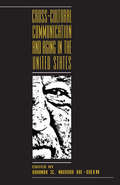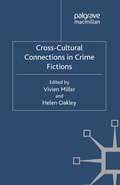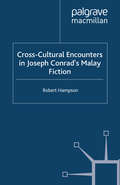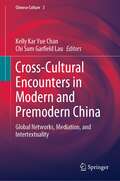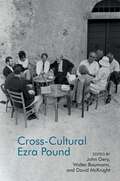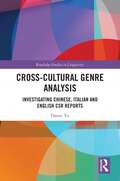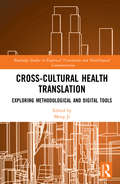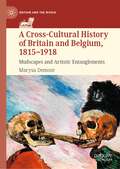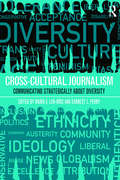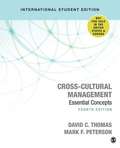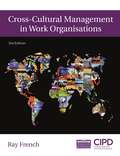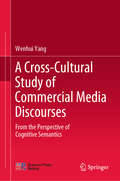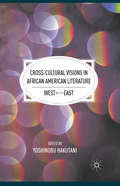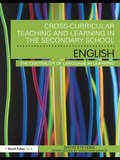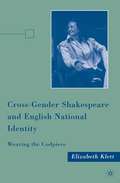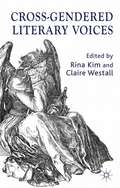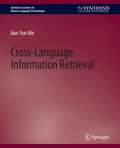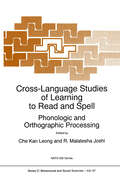- Table View
- List View
Cross Border Treatment - Die Arzthaftung wird europäisch (MedR Schriftenreihe Medizinrecht)
by Ilse Dautert Alexandra JorzigDie Internationalisierung bzw. die Europäisierung macht auch vor dem Arzthaftungsrecht nicht halt. Ob es um die Behandlung eines Urlaubers geht oder um schönheitschirurgische Eingriffe im Ausland, in all diesen Situationen werden mehrere Rechtsordnungen berührt. Die Frage, welches Recht anzuwenden ist, beantwortet das internationale Privat- und Zivilverfahrensrecht. Die Beiträge des XX. Kölner Symposiums der Arbeitsgemeinschaft Rechtsanwälte im Medizinrecht e. V. zeigen die verschiedenen Anforderungen der europäischen Arzthaftung auf.
Cross-Cultural Communication: Theory and Practice
by B. Hurn B. TomalinA comprehensive survey of the key areas of research in cross-cultural communication, based on the authors' experience in organizing and delivering courses for undergraduate and postgraduate students and in business training in the UK and overseas.
Cross-cultural Communication and Aging in the United States (Routledge Communication Series)
by Hana Noor Al-DeenRecently, the communication discipline has devoted increasing energy toward the study of aging, yet most of the research has insufficiently addressed a crucial factor in communicative relationships--culture. Meanwhile, cross-cultural/intercultural communication has not adequately addressed the aging process. Combining three powerful elements--communication, aging, and culture--all of which have an increasingly profound impact on today's multicultural society, this book focuses on older Americans in various communicative contexts within the framework of their cultures. Composed of original research by experts in their respective fields, the book combines communication, aging, and culture for a unique examination of those elements in American society. Section 1 deals with perspectives in cross-cultural communication and aging. These perspectives both illustrate the issues that greatly affect the lives of our elders and suggest ways to improve their status. Section 2 showcases three American co-cultures: Hawaiian, Arab, and Mormon illustrate how language, attitudes, and mentoring can serve as the links for maintaining cross-generational continuity in multicultural society. Section 3 demonstrates that many American organizations frequently contribute to the hardships that both internal elder customers (employees) and external elder customers (residents and patients) must endure. Section 4 incorporates popular culture and aging. It presents the role of selective popular media in portraying our elders. Because Americans rely heavily on the media, their mediated perceptions can have a profound impact on their attitudes toward the older population. Designed as a reader or supplementary text for college students in communication, gerontology, anthropology, sociology, and other related fields, this text can also be used by professionals in gerontological service areas, by libraries, and as a personal reference. It offers extensive appendices, figures, and tables for additional reference.
Cross-cultural Communication and Aging in the United States (Routledge Communication Series)
by Hana S. Noor Al-Deen Jennings BryantRecently, the communication discipline has devoted increasing energy toward the study of aging, yet most of the research has insufficiently addressed a crucial factor in communicative relationships--culture. Meanwhile, cross-cultural/intercultural communication has not adequately addressed the aging process. Combining three powerful elements--communication, aging, and culture--all of which have an increasingly profound impact on today's multicultural society, this book focuses on older Americans in various communicative contexts within the framework of their cultures. Composed of original research by experts in their respective fields, the book combines communication, aging, and culture for a unique examination of those elements in American society. Section 1 deals with perspectives in cross-cultural communication and aging. These perspectives both illustrate the issues that greatly affect the lives of our elders and suggest ways to improve their status. Section 2 showcases three American co-cultures: Hawaiian, Arab, and Mormon illustrate how language, attitudes, and mentoring can serve as the links for maintaining cross-generational continuity in multicultural society. Section 3 demonstrates that many American organizations frequently contribute to the hardships that both internal elder customers (employees) and external elder customers (residents and patients) must endure. Section 4 incorporates popular culture and aging. It presents the role of selective popular media in portraying our elders. Because Americans rely heavily on the media, their mediated perceptions can have a profound impact on their attitudes toward the older population. Designed as a reader or supplementary text for college students in communication, gerontology, anthropology, sociology, and other related fields, this text can also be used by professionals in gerontological service areas, by libraries, and as a personal reference. It offers extensive appendices, figures, and tables for additional reference.
Cross-Cultural Connections in Crime Fictions
by Vivien Miller and Helen OakleyA collection of ten original essays forging new interdisciplinary connections between crime fiction and film, encompassing British, Swedish, American and Canadian contexts. The authors explore representations of race, gender, sexuality and memory, and challenge traditional categorisations of academic and professional crime writing.
Cross-Cultural Encounters in Joseph Conrad’s Malay Fiction: Writing Malaysia
by R. HampsonThis is the first major study to bring together for examination all of Conrad's Malay fiction: the early novels, Almayer's Folly , An Outcast of the Islands , and Lord Jim ; the two later novels, Victory and The Rescue ; and various short stories, such as The Lagoon and Karain . The volume focuses on cross-cultural encounters, cultural identity and cultural dislocation, paying particular attention to issues of race and gender. He also situates Conrad's fiction in relation to earlier English accounts of South-East Asia.
Cross-Cultural Encounters in Modern and Premodern China: Global Networks, Mediation, and Intertextuality (Chinese Culture #3)
by Kelly Kar Yue Chan Chi Sum Garfield LauThis book presents an essential contribution to approaches in the studies of film, literature, performance, translation, and other art forms within the Chinese cultural tradition, examining East-West cultural exchange and providing related intertextual dialogue. The assessment of cultural exchange in the East-West context involves the original source, the adapted text, and other enigmatic extras incurred during the process. It aims to evaluate the linkage among, but not limited to, literature, film, music, art, and performance. The sections unpack how canonical texts can be read anew in modern society; how ideas can be circulated around the world based on translation, adaptation, and reinvention; and how the global networks of circulation can facilitate cultural interaction and intervention. The authors engage discussions on longstanding debates and controversies relating to Chinese literature as world literature; reconciliations of cultural identity under the contemporary waves of globalization and glocalization; Chinese-Western film adaptations and their impact upon cinematic experiences; an understanding of gendered roles and voices under the social gaze; and the translation of texts from intertextual angles. An enriching intellectual, intertextual resource for researchers and students enthusiastic about the adaptation and transformation process of different genres, this book is a must-have for Sinophiles. It will appeal to world historians interested in the global networks of connectivity, scholars researching cultural life in East Asia, and China specialists interested in cultural studies, translation, and film, media and literary studies.
Cross-Cultural Ezra Pound (Clemson University Press: The Ezra Pound Center for Literature Book Series #6)
This volume gathers fifteen essays that offer new interpretations on Pound’s poetics, as well as new perspectives on his critical reception globally. It includes authors from nine different countries and covers Pound’s work from his beginnings as a young poet in Philadelphia in the first decade of the century through his most productive years as a poet, critic, and translator to the first critical treatments of his work in the 1940s and 50s, and on to translations of The Cantos spanning the last fifty years. Although, in our own era, such terms as “cross-cultural thinking,” “globalism,” “transnationalism,” and “internationalism” remain fluid and can often stir controversy in literary studies, especially in discussion of the impact of modernism, the place of Ezra Pound as a prominent modernist figure worldwide has remained unquestioned throughout the last century.
Cross-cultural Genre Analysis: Investigating Chinese, Italian and English CSR reports (Routledge Studies in Linguistics)
by Danni YuThis unique monograph provides a theoretical and methodological account on how to do cross-cultural genre analysis with the aids of corpus tools. Cross-cultural genre analysis investigates how discourse communities from different cultural backgrounds use language to realize a particular genre. It can shed light on genre nature as well as cultural specificities. The book suggests five specific approaches in doing cross-cultural genre analysis: Investigating genre context; Approaching genre complexity; Exploring genre nature; Exploring culture specificity; and Focusing on specific communicative functions. Each of these approaches is illustrated and demonstrated in a specific chapter with practical analyses of the genre of CSR reports. Covering linguistic analysis of CSR reports in three languages: Chinese, English and Italian, Yu provides insights into implications for both genre theories and CSR communication practice. By applying the cross-cultural perspective in corporate discourse analysis, her book demonstrates how the approach of cross-cultural genre analysis is fruitful and valuable in providing practical insights into the textual practice of CSR reporting in a globalized context. Moreover, in the final parts of the book, Yu illustrates how cross-cultural genre analysis can be applied in the didactic field of writing, translation and cross-cultural studies. This volume is a valuable reference to scholars of genre analysis, corpus-based studies, cross-cultural studies and corporate communication. Moreover, it is also useful for professionals involved in compiling CSR reports. Armed with the knowledge imparted in this book, the reader should be able to analyze other genres from a cross-cultural perspective. In particular, instructions on how to use specific corpus tools are provided in the appendices, which can give scholars basic technical knowledge to approach the field of cross-cultural genre analysis.
Cross-cultural Genre Analysis: Investigating Chinese, Italian and English CSR reports (Routledge Studies in Linguistics)
by Danni YuThis unique monograph provides a theoretical and methodological account on how to do cross-cultural genre analysis with the aids of corpus tools. Cross-cultural genre analysis investigates how discourse communities from different cultural backgrounds use language to realize a particular genre. It can shed light on genre nature as well as cultural specificities. The book suggests five specific approaches in doing cross-cultural genre analysis: Investigating genre context; Approaching genre complexity; Exploring genre nature; Exploring culture specificity; and Focusing on specific communicative functions. Each of these approaches is illustrated and demonstrated in a specific chapter with practical analyses of the genre of CSR reports. Covering linguistic analysis of CSR reports in three languages: Chinese, English and Italian, Yu provides insights into implications for both genre theories and CSR communication practice. By applying the cross-cultural perspective in corporate discourse analysis, her book demonstrates how the approach of cross-cultural genre analysis is fruitful and valuable in providing practical insights into the textual practice of CSR reporting in a globalized context. Moreover, in the final parts of the book, Yu illustrates how cross-cultural genre analysis can be applied in the didactic field of writing, translation and cross-cultural studies. This volume is a valuable reference to scholars of genre analysis, corpus-based studies, cross-cultural studies and corporate communication. Moreover, it is also useful for professionals involved in compiling CSR reports. Armed with the knowledge imparted in this book, the reader should be able to analyze other genres from a cross-cultural perspective. In particular, instructions on how to use specific corpus tools are provided in the appendices, which can give scholars basic technical knowledge to approach the field of cross-cultural genre analysis.
Cross-Cultural Health Translation: Exploring Methodological and Digital Tools (Routledge Studies in Empirical Translation and Multilingual Communication)
by Meng JiHealth translation represents a critical yet underexplored research field in Translation Studies. High-quality health translation represents an integral part in the development of multicultural health resources. The empirical study and evaluation of health translations, and the establishment of effective health translation methods and models, holds the key to the success of multicultural health communication and promotion. Chapters in this book aim to fill in a persistent knowledge gap in current multicultural health research, that is, culturally effective and user-oriented healthcare translation. Research presented in this book points to an important opportunity to improve and enhance current multicultural healthcare services based on empirical, evidence-based health translation studies. Health translation provides a powerful intervention tool to engage with migrants with diverse language, cultural backgrounds and health literacy levels. This book provides much-needed reading in the emerging research field of healthcare translation. It makes useful and original contributions to this emerging research field through the exploration of culturally effective health translation methods, approaches and models, as well as the development and evaluation of digital health translation resources and tools.
Cross-Cultural Health Translation: Exploring Methodological and Digital Tools (Routledge Studies in Empirical Translation and Multilingual Communication)
by Meng JiHealth translation represents a critical yet underexplored research field in Translation Studies. High-quality health translation represents an integral part in the development of multicultural health resources. The empirical study and evaluation of health translations, and the establishment of effective health translation methods and models, holds the key to the success of multicultural health communication and promotion. Chapters in this book aim to fill in a persistent knowledge gap in current multicultural health research, that is, culturally effective and user-oriented healthcare translation. Research presented in this book points to an important opportunity to improve and enhance current multicultural healthcare services based on empirical, evidence-based health translation studies. Health translation provides a powerful intervention tool to engage with migrants with diverse language, cultural backgrounds and health literacy levels. This book provides much-needed reading in the emerging research field of healthcare translation. It makes useful and original contributions to this emerging research field through the exploration of culturally effective health translation methods, approaches and models, as well as the development and evaluation of digital health translation resources and tools.
A Cross-Cultural History of Britain and Belgium, 1815–1918: Mudscapes and Artistic Entanglements (Britain and the World)
by Marysa DemoorThis book highlights the ways in which Britain and Belgium became culturally entangled as a result of their interaction in the period between the Napoleonic Wars and the First World War. In the course of the nineteenth century, the battlefields of Waterloo and Ypres in Belgium became veritable burial grounds for generations of dead British military, indirectly leading to the most intensive ties between the two countries. By exploring this twofold path, the author uncovers a series of cross-influences and creative similarities within the Belgo-British artistic community, and explores the background against which the British national identity was constructed. Revealing unknown links between some of the most famous artists on both sides of the channel, such as D.G. Rossetti and Jan Van Eyck; Christina Rossetti and Fernand Khnopff; John Millais and Pieter Breughel, and Lewis Carroll and Quentin Massys, the book emphasises an artistic cross-fertilisation that can be found within battlefield literature throughout the nineteenth century, including examples from the likes of William M. Thackeray, Frances Trollope and Charlotte Brontë. Providing a rich intercultural history of Belgo-British relations after the battle of Waterloo, this interdisciplinary book will appeal to scholars and students researching history, literature, art and cultural studies.
Cross-Cultural Journalism: Communicating Strategically About Diversity
by Maria Len-Rios Earnest PerryBuilt on the hands-on reporting style and curriculum pioneered by the University of Missouri, this introductory textbook teaches students how to write about and communicate with people of backgrounds that may be different from their own, offering real-world examples of how to practice excellent journalism and strategic communication that take culture into account. Specifically, the book addresses how to: engage with and talk across difference; identify the ways bias can creep into our communications, and how to mitigate our tendencies toward bias; use the concept of fault lines and approach sources and audiences with humility and respect; communicate with audiences about the complexity inherent in issues of crime, immigration, sports, health inequalities, among other topics; interpret census data categories and work with census data to craft stories or create strategic campaign strategies; reconsider common cultural assumptions about race, class, gender, identity, sexual orientation, immigration status, religion, disability, and age, and recognize their evolving and constructed meaning and our role as professional communicators in shaping national discussions of these issues. In addition to its common sense, practical approach, the book’s chapters are written by national experts and leading scholars on the subject. Interviews with award-winning journalists, discussion questions, suggested activities, and additional readings round out this timely and important new textbook. Supplemented by additional case studies and examples of best practice, Cross-Cultural Journalism offers journalists and other communication professionals the conceptual framework and practical know-how they need to report and communicate effectively about difference.
Cross-Cultural Journalism: Communicating Strategically About Diversity
by Maria Len-Rios Earnest PerryBuilt on the hands-on reporting style and curriculum pioneered by the University of Missouri, this introductory textbook teaches students how to write about and communicate with people of backgrounds that may be different from their own, offering real-world examples of how to practice excellent journalism and strategic communication that take culture into account. Specifically, the book addresses how to: engage with and talk across difference; identify the ways bias can creep into our communications, and how to mitigate our tendencies toward bias; use the concept of fault lines and approach sources and audiences with humility and respect; communicate with audiences about the complexity inherent in issues of crime, immigration, sports, health inequalities, among other topics; interpret census data categories and work with census data to craft stories or create strategic campaign strategies; reconsider common cultural assumptions about race, class, gender, identity, sexual orientation, immigration status, religion, disability, and age, and recognize their evolving and constructed meaning and our role as professional communicators in shaping national discussions of these issues. In addition to its common sense, practical approach, the book’s chapters are written by national experts and leading scholars on the subject. Interviews with award-winning journalists, discussion questions, suggested activities, and additional readings round out this timely and important new textbook. Supplemented by additional case studies and examples of best practice, Cross-Cultural Journalism offers journalists and other communication professionals the conceptual framework and practical know-how they need to report and communicate effectively about difference.
Cross-cultural Management: Essential Concepts (PDF)
by David C. Thomas Mark F. PetersonCross-Cultural Management: Essential Concepts introduces readers to the fundamentals of cross-cultural management by exploring the influence of culture on interpersonal interactions in organizational settings and examining the ever-increasing number of cross-cultural challenges that global managers face in today’s workplace. The Fourth Edition reflects the most current thinking on the topic.
Cross-Cultural Management in Work Organisations
by Ray FrenchCross-Cultural Management is the essential introduction to cross-cultural social relations in the work setting. Alternate ISBNS 9781843981497 9781843982432
A Cross-Cultural Study of Commercial Media Discourses: From the Perspective of Cognitive Semantics
by Wenhui YangThis book decodes commercial news discourses from the perspective of cognitive semantics. It attaches considerable importance to the bodily experientialism and linguistic embodiment advocated in discourse analysis and cognitive linguistics and explores the complex yet thought-provoking correlation between overt language and covert cognition by focusing on contrastive analyses of metaphors, image schemas, and stance markers in texts. On the basis of the analyses, the author discusses the linguistic applications, lexical devices and personal experiences, along with their embodied mechanisms, revealing the linguistic strategies, embodied cognitive linguistic actions and constructive thoughts used in media discourses on product promotion, human resources deployment, and commodity problem resolution. In turn, this sheds light on how linguistic selections and cognitive mechanisms are used in composing media news and on how public cognition on certain social and business issues might be framed.The combination of cognitive semantics and commercial discourse analysis offers comprehensive and rewarding insights into the cross-cultural research of both cognitive actions and linguistic behavior reflected in news reports and highlights the correlation between the use of wording and cognitive construction in discourses, which broadens the scope of discourse analysis, cognitive linguistics, applied linguistics, and sociolinguistics. Further, the use of analytical measures and the effective integration of discourse analysis and cognitive semantics lend the book additional analytical authenticity, providing an empirical foundation for cross-cultural communication studies.
Cross-Cultural Visions in African American Literature: West Meets East
by Yoshinobu HakutaniThe most influential East-West artistic, cultural, and literary exchange that has taken place in modern and postmodern times was the reading and writing of haiku. Here, esteemed contributors investigate the impact of Eastern philosophy and religion on African American writers such as Richard Wright, Ralph Ellison, and Toni Morrison, offering a fresh field of literary inquiry.
Cross-Curricular Teaching and Learning in the Secondary School ... English: The Centrality of Language in Learning
by David StevensWhat is the role of the individual school 'subject' and 'subject teacher' within school? Is it to teach a set of core subject knowledge, skills and understanding in a way that remains faithful to long-standing subject cultures and pedagogies? Or is there another way to consider how the curriculum and the notion of individual subjects and teachers' pedagogy could be constructed? Cross-Curricular Teaching and Learning in the Secondary School ... English brings together ongoing debates about personalised learning, creativity and ICT in education to establish a clear theoretical framework for cross-curricular teaching and learning in English and literacy. Presenting an appropriate pedagogy for cross-curricular teaching that draws on this framework, it promotes radical new approaches to English teaching as part of a widened curriculum through practical examples and theoretical discussions, blended with engaging stories of current practice. With links to other curriculum subjects and current education policy, features include: theoretical examination of key issues; assessment of the strengths and weaknesses of different curricular models; clear principles for effective assessment; a wide range of case studies; summaries of key research linked to suggestions for further reading; professional development activities to promote cross-curricular dialogue. Part of the Cross-Curricular Teaching and Learning in the Secondary School series, this timely, interdisciplinary textbook is essential reading for all students on Initial Teacher Training courses and practising teachers looking to holistically introduce cross-curricular themes and practices in secondary English teaching.
Cross-Curricular Teaching and Learning in the Secondary School ... English: The Centrality of Language in Learning
by David StevensWhat is the role of the individual school 'subject' and 'subject teacher' within school? Is it to teach a set of core subject knowledge, skills and understanding in a way that remains faithful to long-standing subject cultures and pedagogies? Or is there another way to consider how the curriculum and the notion of individual subjects and teachers' pedagogy could be constructed? Cross-Curricular Teaching and Learning in the Secondary School ... English brings together ongoing debates about personalised learning, creativity and ICT in education to establish a clear theoretical framework for cross-curricular teaching and learning in English and literacy. Presenting an appropriate pedagogy for cross-curricular teaching that draws on this framework, it promotes radical new approaches to English teaching as part of a widened curriculum through practical examples and theoretical discussions, blended with engaging stories of current practice. With links to other curriculum subjects and current education policy, features include: theoretical examination of key issues; assessment of the strengths and weaknesses of different curricular models; clear principles for effective assessment; a wide range of case studies; summaries of key research linked to suggestions for further reading; professional development activities to promote cross-curricular dialogue. Part of the Cross-Curricular Teaching and Learning in the Secondary School series, this timely, interdisciplinary textbook is essential reading for all students on Initial Teacher Training courses and practising teachers looking to holistically introduce cross-curricular themes and practices in secondary English teaching.
Cross-Gender Shakespeare and English National Identity: Wearing the Codpiece
by E. KlettThis book examines contemporary female portrayals of male Shakespearean roles and shows how these performances invite audiences to think differently about Shakespeare, the English nation, and themselves.
Cross-Gendered Literary Voices: Appropriating, Resisting, Embracing
by Rina Kim and Claire WestallThis book investigates male writers' use of female voices and female writers' use of male voices in literature and theatre from the 1850s to the present, examining where, how and why such gendered crossings occur and what connections may be found between these crossings and specific psychological, social, historical and political contexts.
Cross-Language Information Retrieval (Synthesis Lectures on Human Language Technologies)
by Jian-Yun NieSearch for information is no longer exclusively limited within the native language of the user, but is more and more extended to other languages. This gives rise to the problem of cross-language information retrieval (CLIR), whose goal is to find relevant information written in a different language to a query. In addition to the problems of monolingual information retrieval (IR), translation is the key problem in CLIR: one should translate either the query or the documents from a language to another. However, this translation problem is not identical to full-text machine translation (MT): the goal is not to produce a human-readable translation, but a translation suitable for finding relevant documents. Specific translation methods are thus required. The goal of this book is to provide a comprehensive description of the specific problems arising in CLIR, the solutions proposed in this area, as well as the remaining problems. The book starts with a general description of the monolingual IR and CLIR problems. Different classes of approaches to translation are then presented: approaches using an MT system, dictionary-based translation and approaches based on parallel and comparable corpora. In addition, the typical retrieval effectiveness using different approaches is compared. It will be shown that translation approaches specifically designed for CLIR can rival and outperform high-quality MT systems. Finally, the book offers a look into the future that draws a strong parallel between query expansion in monolingual IR and query translation in CLIR, suggesting that many approaches developed in monolingual IR can be adapted to CLIR. The book can be used as an introduction to CLIR. Advanced readers can also find more technical details and discussions about the remaining research challenges in the future. It is suitable to new researchers who intend to carry out research on CLIR. Table of Contents: Preface / Introduction / Using Manually Constructed Translation Systems and Resources for CLIR / Translation Based on Parallel and Comparable Corpora / Other Methods to Improve CLIR / A Look into the Future: Toward a Unified View of Monolingual IR and CLIR? / References / Author Biography
Cross-Language Studies of Learning to Read and Spell: Phonologic and Orthographic Processing (NATO Science Series D: #87)
by R. MalateshaJoshi Che KanLeongThe present volume is based on the proceedings of the Advanced Study Institute (AS I) sponsored by the North Atlantic Treaty Organization (NATO) held in Alvor, Algarve, Portugal. A number of scholars from different countries participated in the two-week institute on Cognitive and linguistic aspects of reading, writing, and spelling. The present papers are further versions with modifications and refinements from those presented at the Advanced Study Institute. Several people and organizations have helped us in this endeavor and their assistance is gratefully acknowledged. Our special thanks are to: the Scientific Affairs division of NATO for providing the major portions of the financial support, Dr. L.V. da Cunha of NATO and Dr. THo Kester and Mrs. Barbara Kester of the International Transfer of Science and Technology of the various aspects of the institute; and (ITST) for their help and support the staff of Hotel Alvor Praia for making our stay a pleasant one by helping us to run the institute smoothly.
